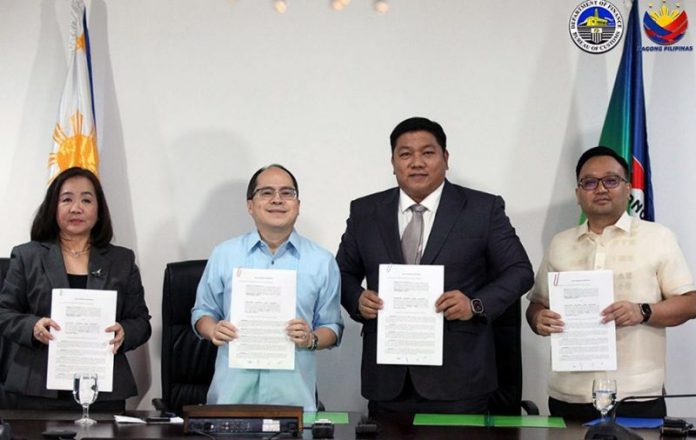
-
The Bureau of Customs and Philippine Economic Zone Authority signed a data sharing agreement allowing the latter access to BOC’s Electronic Tracking of Containerized Cargo
-
Under the agreement signed on September 5, PEZA will have access in tracking, monitoring and auditing the location and condition of cargoes, as well as obtain real-time alarms on diversion and tampering of cargoes
-
PEZA also reiterated its support to the implementation of the Electronic Zone Transfer System under the data sharing agreement
The Philippine Economic Zone Authority (PEZA) and Bureau of Customs (BOC) signed a data sharing agreement allowing the investment promotions agency access to BOC’s Electronic Tracking of Containerized Cargo (E-TRACC) System.
Under the agreement signed on September 5 by PEZA director general Tereso Panga and Customs Commissioner Bienvenido Rubio, PEZA will gain access to BOC’s E-TRACC System data, enabling real-time tracking and monitoring of containerized goods within and outside economic zones.
PEZA will also be able to obtain real-time alarms on diversion and tampering of cargoes. This is to ensure that importation and exportation of tax- and duty-free goods arrive and reach the intended PEZA economic zones/port loading, PEZA said in a statement.
The agreement promotes the integration, interoperability and interconnection of both agencies’ respective systems in direct compliance to Executive Order 18 that establishes Green Lanes for strategic investments, PEZA added.
Key provisions of the agreement focus on data privacy, security, storage, and retention of confidential information.
“We firmly believe that sharing secured data with PEZA will enable us to coordinate our efforts and drive collective improvements toward seamless trade facilitation. Surely, this will pave the way for improved day-to-day operations and will further buttress our trade facilitation performances,” Rubio said in a separate statement.
For his part, Panga noted: “We subscribe to the BOC’s objectives of trade facilitation as our way of enhancing the competitiveness of the Philippines for trade and investments. To do this, we believe that digitalization is the key, increased adoption of automation, so that we can enhance our ease of doing business and facilitate even more the movement of cargoes of our locators.”
E-TRACC is a web-based system launched in 2020 that tracks the inland movement of containerized cargoes during transit and transfer to other customs territories and facilities. It allows BOC to track, monitor, and audit the location and condition of cargoes, as well as obtain real-time alarms on diversion and tampering of cargoes.
Under Customs Memorandum Order (CMO) No. 04-2020, which implements the E-TRACC System, an electronic customs seal is required during the transfer of cargo to a container yard/container freight station (CY/CFS) or other customs facilities and warehouses; transit of cargo bound for Free Zones, inland customs office, depots, or terminals; transit to customs bonded warehouses (CBW); export of cargo from Free Zones, inland customs office, depots or terminals, and CBWs to port of loading; and transfer of shipments subject to further verification and/or monitoring.
EZTS implementation
In line with the data sharing agreement and efforts of the agencies towards digitalization, PEZA also reiterated its support to the implementation of the Electronic Zone Transfer System (eZTS) as contained in Joint Memorandum Order (JMO) No. 2-2015 dated July 24, 2015.
BOC and PEZA in 2015 signed the JMO to implement e-ZTS to further facilitate the conduct of business by PEZA-registered enterprises.
PEZA had initially deferred for a month the implementation of the INTERZONE module of eZTS due to the non-processing of general transportation surety bond (GTSB) by Philippine insurers and some BOC zones.
PEZA said both parties later continued the INTRAZONE module, with inclusion of more type of transactions to be covered by the fully automated facilitation such as eNomination/eCertification, eLOA and eMonitoring Ledger and real time monitoring on the status of goods for transfer.
According to Panga, “With more Value-Added Services Providers (VASPs) and bonding companies supporting the eZTS, the locators will benefit more from reduced cost and better services of multiple providers. The system will also allow for continued usage of GTSB for import shipments to cover the subsequent movement of cargoes for interzone sales/transfers, thereby removing the current requirement of posting a surety bond for every LOA withdrawal of locators’ production materials from the zones.”
The eZTS is an automated system which facilitates the conduct of business by PEZA registered business enterprises (RBEs) through the implementation of a simpler and more efficient system for documenting and processing the clearance, release and transfer of goods between PEZA and RBEs, in a more secure and transparent manner, with lower service fees, and providing timely report for data analytics.
To date, PEZA houses 4,352 locator companies, mostly export-oriented, across 422 ecozones nationwide.
RELATED READ: New E-TRACC feature, mobile app version introduced




